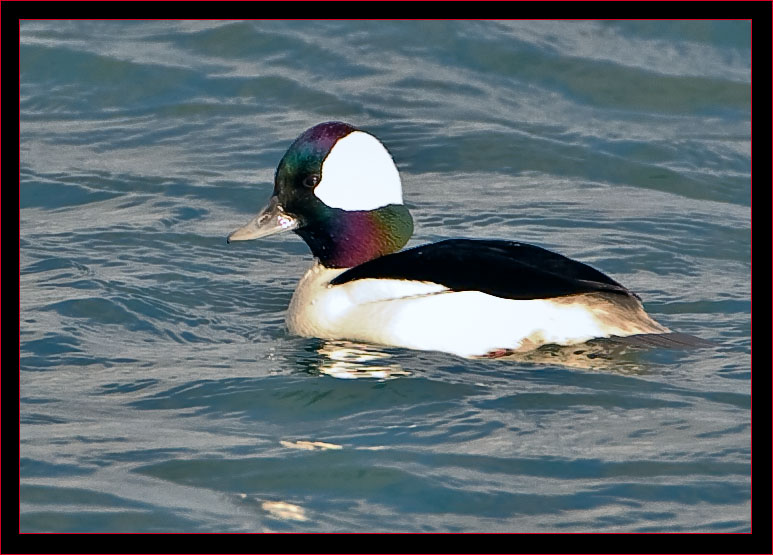You’ve got to love a bird with a name like “Bufflehead.” The Bufflehead, for those of you who don’t know, is a small (the smallest of our diving ducks), black-and-white duck that spends the winter in sheltered bays and coves along our coast. Maine is actually near the northern limits of its winter range but small flocks of bobbing Buffleheads are a common sight just about anywhere from Eastport to Kittery.
The name “Bufflehead” is said to be a corruption of the term “buffalo head,” which appeared in print as early as 1791 to refer to the species and which is said to be a reference to the male’s large, puffy-looking head. Take a closer look and you may notice that the “black” head is actually glossy green and purple, all the more striking for being offset by a striking wedge of white. Female Buffleheads have a much smaller patch of white on the head and replace the green and purple with a subtler gray-brown.
Buffleheads nest in old woodpecker holes, particularly those excavated by Northern Flickers, near small ponds and lakes in the boreal forests of northern North America, from interior Alaska east to western Quebec, with a few small, isolated populations in the western U.S. There are records of the species showing up in places much farther afield, including Iceland, Japan, France, Finland and Czechoslovakia, though in some cases, they are thought to have been escaped or released captive birds.
Like many ducks, they lay large clutches of 6 to 11 eggs; presumably, many of the newly hatched ducklings are lost to predators or starvation. Unlike most other ducks, Buffleheads are monogamous and remain with the same mate for many years. During the summer nesting season, the adults and young feed on aquatic insect larvae and other freshwater aquatic invertebrates.
Although they are considered quieter than many of their ducky relatives, they do vocalize, with males chattering while courting females with their head-bobbing displays. Females give a cok-cok-cok while checking out nesting sites and call to their young as a signal to hurry along.
Buffleheads can live to be 15 years old or longer—though there is possibly one that is more than 2 million years old (if you include a fossil record from California!). In the past, they’ve suffered population declines from overhunting, but their populations seem to have remained fairly stable over the last decade. Their numbers remain under careful watch as they face the threat of habitat loss in their boreal forest breeding range. Some 200,000-250,000 are shot each year in North America.
Look for Buffleheads in any sheltered water around Wiscasset, Edgecomb and Boothbay areas. Watch them bob on the surface then dive completely out of sight , reappearing nearby—kind of like a cork popped out of a bottle to wish us all a Happy 2013!
Dr. Jeff Wells is the senior scientist for the Boreal Songbird Initiative. During his time at the famed Cornell Lab of Ornithology and as the Audubon Society's national bird conservation director, Dr. Wells earned a reputation as one of the nation's leading bird experts and conservation biologists. Jeff's grandfather, the late John Chase, was a columnist for the Boothbay Register for many years. Allison Childs Wells, also formerly of the Cornell Lab of Ornithology, is a widely published natural history writer and a senior director at the Natural Resources Council of Maine. Together, they have been writing and teaching people about birds for decades. The Maine natives are authors of the highly acclaimed book, “Maine's Favorite Birds.”





























